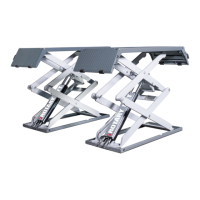9
1.3 Intended use
The scissor lift may only be used:
•
In indoor areas for lifting unoccupied motor vehi-
cles.
•
For lifting vehicles with a max. load capacity of
3500kg.
•
If the weight is distributed correctly. By default, the
load should be centered in the direction of motion.
If the main load (e.g. engine) is however at the
front or the back, the following applies:
at front max. 3/5,
at back 2/5 of load or vice versa.
•
With correctly aligned, adjustable runways. The
vehicle must be approximately centered on the two
platforms.
•
In accordance with the technical data in Chapter 7,
in technically sound condition.
1.4 Incorrect use, incorrect behavior
Incorrect behavior presents a residual risk to the
life and health of the people working in the lift area.
The manufacturer assumes no liability for
damage resulting from use other than the intended
purpose and from incorrect behavior.
The following is prohibited:
•
Climbing onto or riding on the scissor lift or the
load.
•
Lifting when there are people in the vehicle.
•
Lifting/lowering when people or animals are in the
danger zone, in particular below the lift.
•
Jerky lifting or lowering. Do not cause the lift to
vibrate.
•
Throwing objects onto or under the lift.
•
Lifting a vehicle at the incorrect pick-up points .
•
Lifting a load on only one platform of the lift.
•
Lifting loads not listed in Chapter 1.3.
• Lifting vehicles containing hazardous goods.
•
Operating outdoors or in workshops at risk from
re or explosion.
•
Washing cars on the scissor lift.
•
Modications of any kind.
1.5 Internal accident, health and safety, and
environmental information
This operating manual does not include the ope-
rating instructions which need to be drafted by the
user of the scissor lift.
The internal operating instructions regulate acti-
ons within the company for the prevention of accid-
ents, and risks to health & safety and the environm-
ent.
These also include actions in the case of an
emergency, rst aid measures etc.

